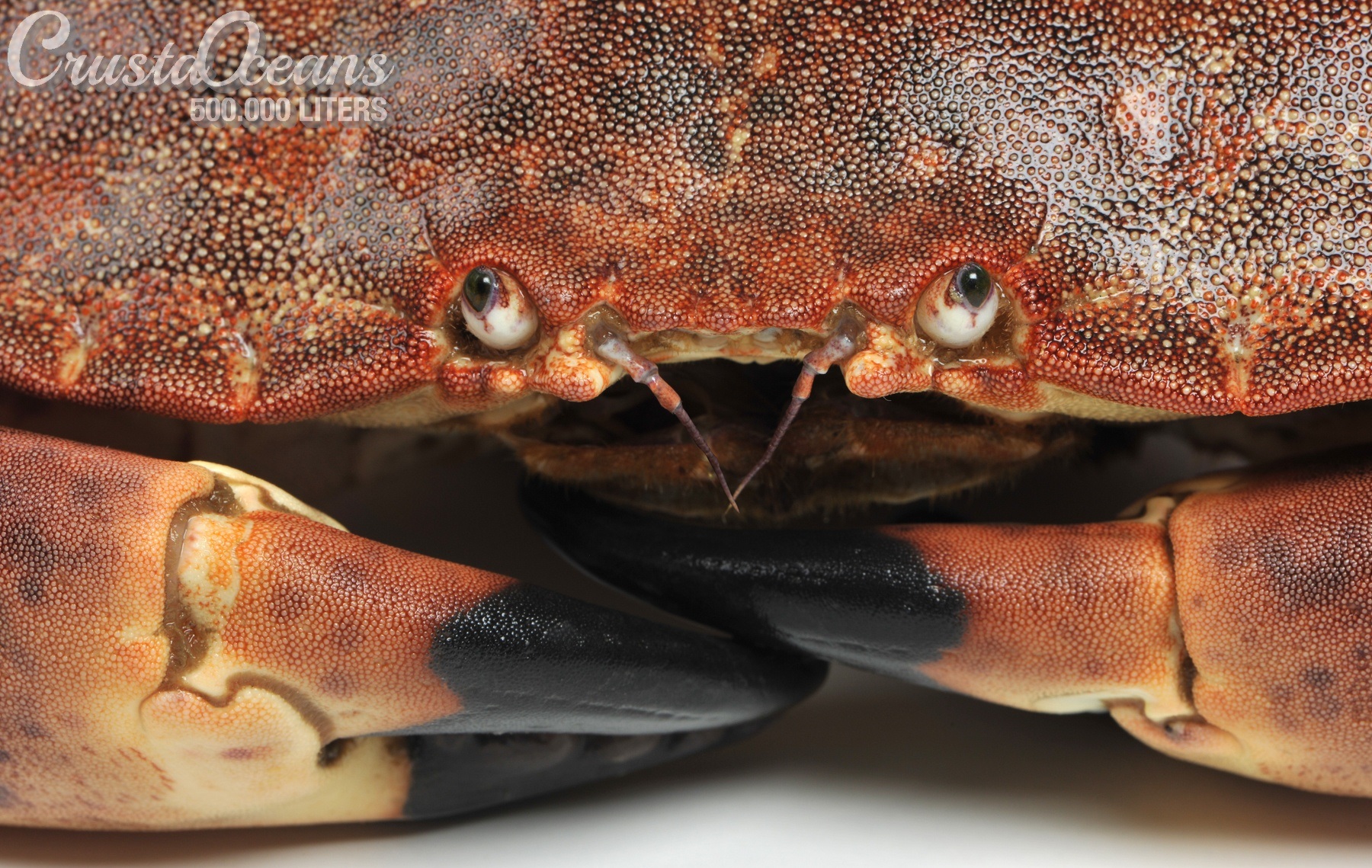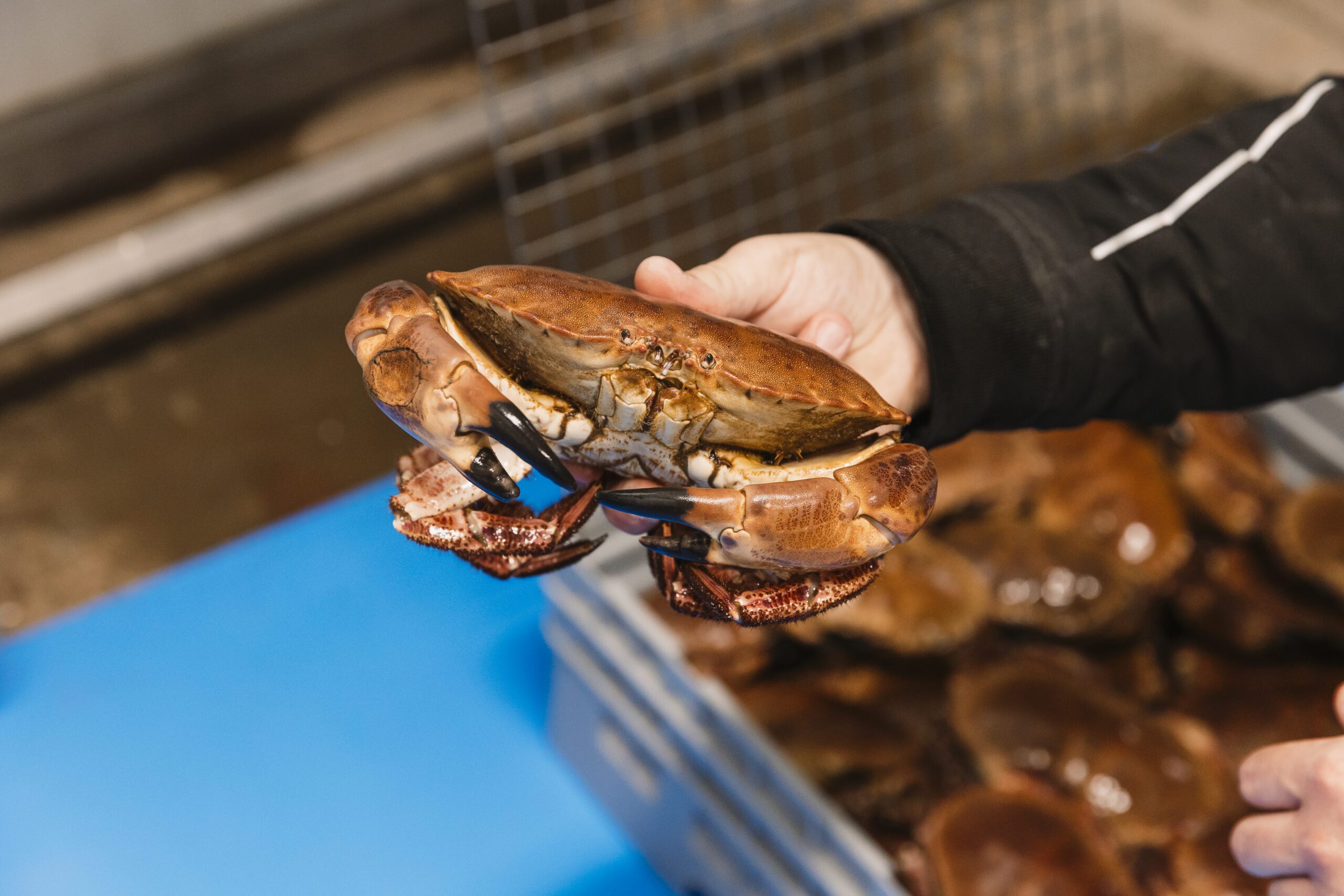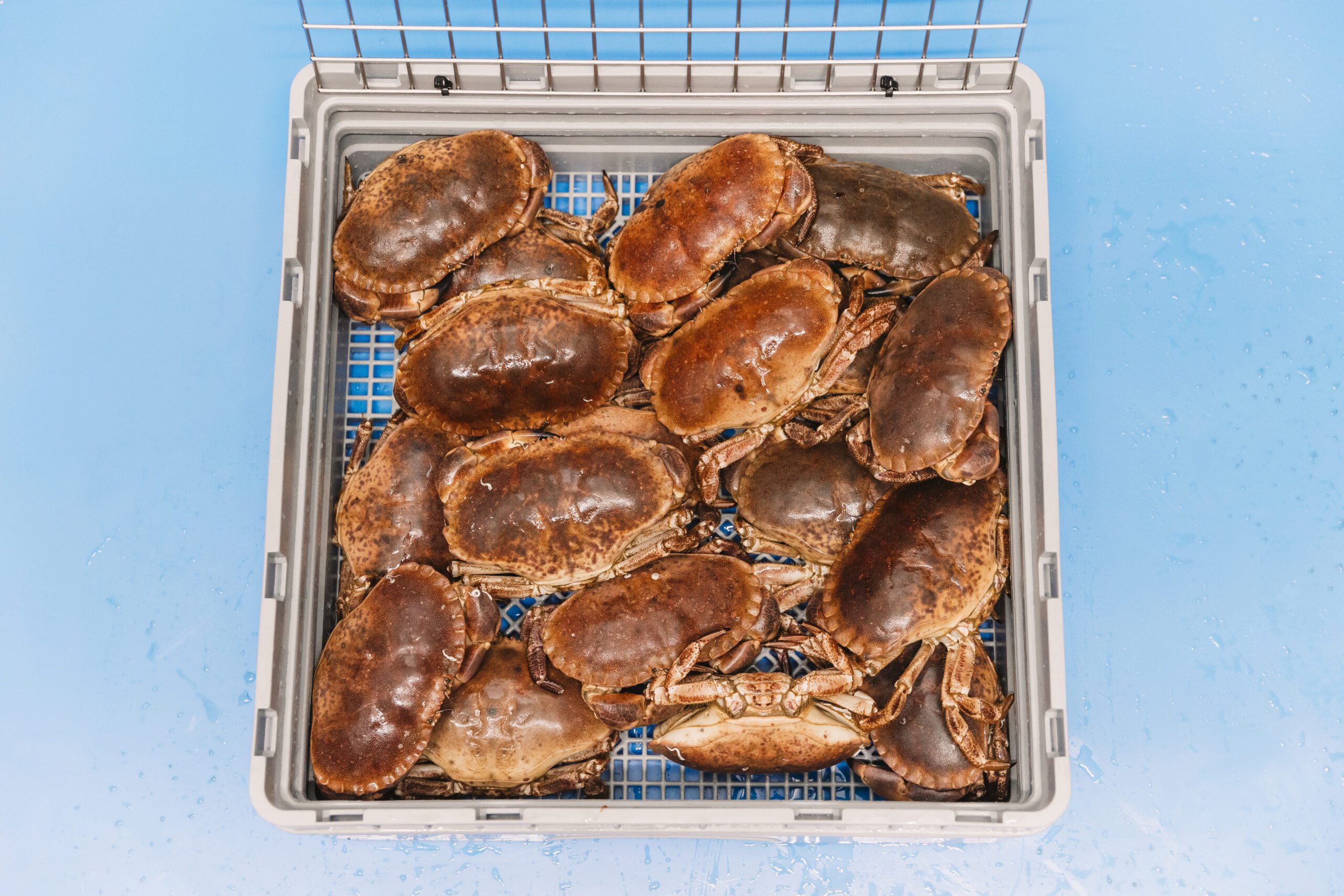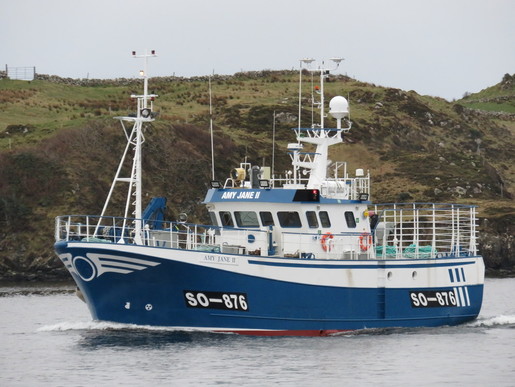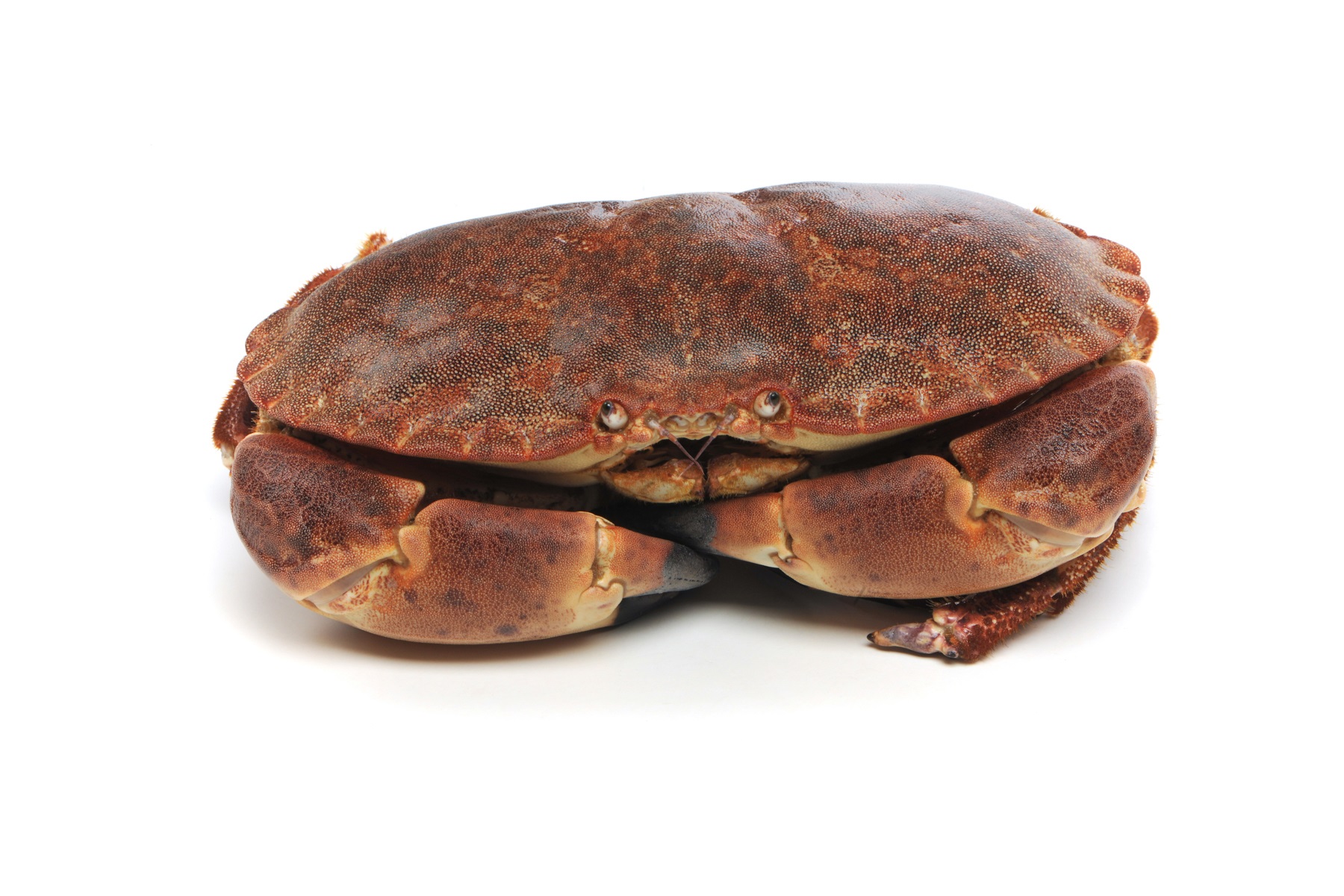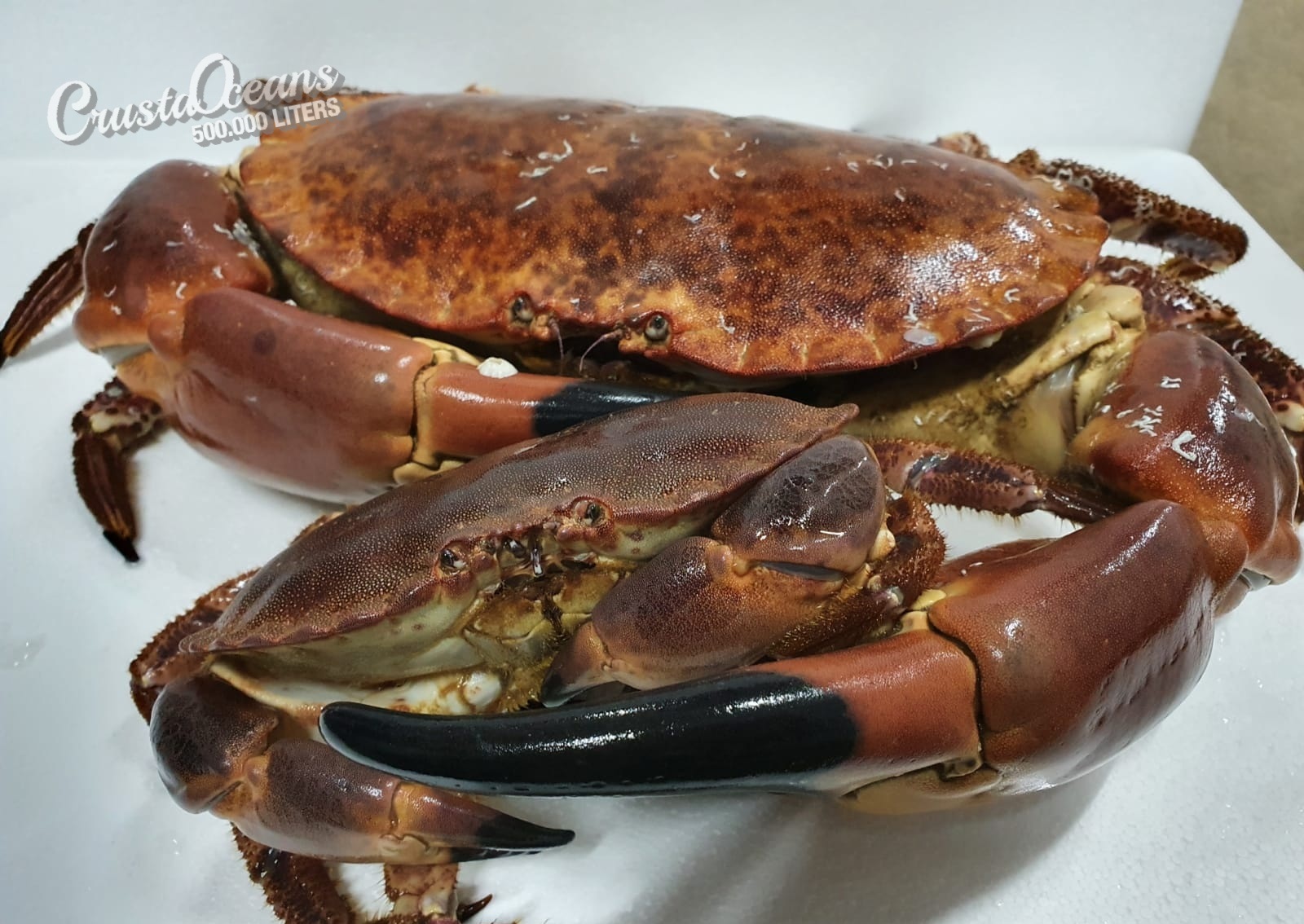Description
Taste the flavorful meat of the North Sea crab! Whether you are a gourmet or a professional chef, this product offers an unparalleled taste experience. This robust crab, also known as the brown crab, is famous for its sweet, delicate meat and is a must-have delicacy in European cuisine. At Crusta Oceans, North Sea crab is available both live and frozen.
What is a Brown Crab?
The North Sea crab, scientifically known as Cancer pagurus, is an impressive crustacean that lives in the cool waters of the northeastern Atlantic Ocean, including the North Sea. These crabs are easy to recognize by their characteristic appearance. The upper part of their shell has a chestnut brown color, helping them blend into the seabed, while the underside of their body and legs are lighter in color, ranging from yellowish to creamy. Their shell is broad and oval-shaped, reaching up to 25 centimeters in width for adult specimens. The edge of the shell is slightly serrated, giving it a somewhat jagged appearance. In terms of size, this crab can weigh up to 3 kilograms. The North Sea crab has ten legs, with the front two transformed into powerful claws. These claws have a rough, knobby texture and are usually slightly darker at the tips. They are particularly strong and are used to grasp and break food. The other eight legs are relatively long and help the crab walk along the seabed. These legs have small hairs that assist the crab in navigating and detecting vibrations in the water. The North Sea crab, an important member of the Cancridae family, is native to the northeastern Atlantic Ocean and the North Sea. These crabs can also be found along the coast from Norway to Morocco, including the western Mediterranean.
Habitat and Behavior
North Sea crabs are nocturnal creatures that hide during the day in crevices and under rocks. They emerge at night to hunt and forage for food. Their diet consists mainly of mollusks, such as mussels and shells, but they also feed on fish, worms, and other smaller shellfish. These crabs play an important role in the ecosystem as predators and scavengers, helping to maintain the balance of marine life. North Sea crabs are widespread in the northeastern Atlantic Ocean, from Norway and the British Isles to Morocco. They are often found in coastal areas with hard bottoms, such as rocks, pebble, and sandy beaches. Juvenile crabs are usually found in shallower waters, while adults prefer deeper waters, up to about 100 meters deep. They are well-adapted to varying temperatures, although they prefer cooler waters of 10 to 20 degrees Celsius. These crabs are also highly mobile and can travel considerable distances in search of food or new habitats. The mobility of the North Sea crab is a key factor in their ability to colonize different habitats and maintain their populations.
Reproduction and Lifestyle
The reproduction of North Sea crabs usually takes place in late summer and early autumn. Females carry the fertilized eggs under their abdomen until they hatch in early spring. A female can produce up to 3 million eggs at a time, which she protects for several months. The larvae, known as zoea, go through various developmental stages in the water column before settling on the seabed and further developing into adult crabs. The life cycle of the North Sea crab includes several stages, from larva to juvenile and eventually adult crab. These animals can live up to 20 years, depending on environmental factors. The crabs molt regularly, especially during growth phases, shedding their old exoskeleton and forming a new, larger one. Molting is a crucial process for the growth and reproduction of these crabs, as it allows them to replace damaged or aging parts of their exoskeleton. The larval stages of the North Sea crab are particularly vulnerable and are influenced by a range of environmental factors, such as temperature, salinity, and food availability. Successful development from larvae to juveniles depends on favorable conditions in their habitat.
Nutritional Values
North Sea crabs are not only a culinary treat due to their flavor but also for their nutritional value. Crab meat is rich in protein, low in fat and calories, making it a healthy choice for those seeking a balanced diet. Here are some key nutritional values of North Sea crab meat per 100 grams:
Calories: 97 kcal
Protein: 20 grams
Fat: 1.5 grams
Carbohydrates: 0 grams
Cholesterol: 55 mg
Sodium: 295 mg
In addition, crab meat is a good source of essential vitamins and minerals, such as vitamin B12, zinc, copper, and selenium. Vitamin B12 is crucial for red blood cell production and nervous system health, while zinc and selenium are important for a healthy immune system and proper thyroid function. Eating North Sea crab can contribute to a balanced diet and offers numerous health benefits. The low fat content in crab meat makes it a suitable choice for those looking to limit their fat intake, while the high protein content supports muscle building and repair. Selenium and zinc play a role in supporting the immune system and promoting healthy skin and hair.
Culinary Applications
North Sea crabs are a beloved ingredient in many cuisines, especially in Europe. They are often cooked and served whole, with the delicate and sweet meat from the claws and body enjoyed. Here are some popular preparation methods and dishes:Boiled Crab:
Simply boiled and served with lemon and a pinch of salt to fully appreciate the natural flavors of the crab meat.
Crab Salad:.
A fresh salad with crab meat, mixed with mayonnaise, lemon, herbs, and sometimes avocado.
Crab Cakes:
Fried crab cakes made from a mixture of crab meat, breadcrumbs, eggs, and herbs.
Crab Bisque:
A rich, creamy soup made from crab meat and shell, flavored with cognac and cream.
Crab meat can also be used in pasta, risotto, sushi, and as a filling for various dishes like ravioli or empanadas. The versatility of crab meat makes it a favorite among chefs looking for high-quality ingredients to elevate their dishes.
Fishing and Sustainability
North Sea crabs are caught in a sustainable and eco-friendly manner, primarily using traps. This method is selective and environmentally responsible, minimizing the impact on the seabed and reducing bycatch of other species. The fishing season typically runs from late spring to early autumn when the crabs are most active and their meat is of the highest quality. Our commitment to sustainability ensures that crab populations remain healthy and abundant. The commercial harvesting of North Sea crabs is an important industry in many European countries. The crabs are mainly caught by small-scale fishers using traditional techniques that minimize environmental impact. This approach not only supports local economies but also contributes to the preservation of marine habitats. Sustainability initiatives include regulating catch quotas, setting minimum mesh sizes for fishing nets, and limiting fishing efforts during critical breeding periods. These measures help keep crab populations stable and protect the biodiversity of marine ecosystems.
Live Crab Available in the Following Sizes:
(Year-round)
400-800 grams
800-1000 grams
1000+ grams
Different Types of Crab Meat
This shellfish offers various types of meat, each with a unique texture and flavor.
Claw Meat
The meat from the claws is firm, white, and has a subtly sweet taste. This part of the crab is the most recognizable and sought after, thanks to its robust structure and versatility in different dishes. Claw meat is highly popular and is often considered the best part of the crab due to its delicate flavor and firm texture. It is often served as a main dish, processed into gourmet crab cakes, and used in haute cuisine dishes. The combination of firm texture and mild, sweet flavor makes it a favorite.
Leg Meat
The meat from the crab's legs is similar to claw meat but is slightly finer and less firm. It is also white and mildly sweet in taste. Leg meat is popular, especially in salads and as a garnish. It is also often used in sushi and sashimi due to its fine texture, making it a versatile choice for various culinary creations.
Body Meat
The meat from the crab's body is white, soft, and has a fine texture. This meat is often slightly sweeter than that from the claws and legs. Although body meat is popular, it is less appreciated than claw meat. It is often used in dishes where it is combined with other ingredients, such as crab salads, crab bisques, and other seafood dishes. The delicate flavor blends well with various ingredients, making it an excellent choice for composed dishes.
Brown Meat
The brown meat of the North Sea crab comes from the body and head of the crab and has a richer, stronger flavor. This part of the crab is softer and creamier than the white meat and contains more fat. The popularity of brown meat varies. In some culinary traditions, such as French and British cuisine, it is highly valued for its full flavor. It is often used for making rich sauces, pâtés, and bisques. Elsewhere, it is less popular due to its stronger flavor and softer texture.
Live and Frozen Crab Meat
Our North Sea crabs are available both live and frozen, allowing you to enjoy their delicious taste year-round. The live crabs are carefully selected and transported to ensure they arrive in optimal condition. Frozen crab meat is processed and frozen immediately after being caught to preserve freshness and quality. Whether you are looking for whole crabs, crab legs, or peeled crab meat, there is a product to meet your culinary needs. Live crabs offer the ultimate freshness and are ideal for restaurants and culinary professionals aiming to provide their guests with a top-quality dining experience. Frozen crab meat, on the other hand, is convenient for home cooks and offers the same premium taste and texture without concerns about shelf life.



